| |||||||||||||||||||||||||
ARTBOOK BLOGEventsStore NewsMuseum Stores of the MonthNew Title ReleasesStaff PicksImage GalleryBooks in the MediaExcerpts & EssaysArtbook InterviewsEx LibrisAt First SightThe Artbook | D.A.P. 2025 Gift GuidesArtbook Featured Image ArchiveArtbook D.A.P. Events ArchiveDATE 12/11/2025 192 Books presents Raymond Foye and Peter Gizzi on The Song Cave's new edition of John Wiener’s 'Behind the State Capitol: Or Cincinnati Pike'DATE 12/8/2025 Pure winter glamour in ‘It’s Snowing!’DATE 12/3/2025 Flamboyant poses and melodramatic airs in 'Cecil Beaton's Fashionable World'DATE 11/30/2025 Artbook at Hauser & Wirth Los Angeles Bookstore presents Kelli Anderson and Claire L. Evans launching 'Alphabet in Motion'DATE 11/27/2025 Indigenous presence in 'Wendy Red Star: Her Dreams Are True'DATE 11/24/2025 Holiday Gift Guide 2025: Artful Crowd-PleasersDATE 11/22/2025 From 'Bottle Rocket' to 'The Phoenician Scheme' — the archives of Wes AndersonDATE 11/20/2025 The testimonial art of Reverend Joyce McDonaldDATE 11/18/2025 A profound document of art, love and friendship in ‘Paul Thek and Peter Hujar: Stay away from nothing’DATE 11/17/2025 The Strand presents Kelli Anderson + Giorgia Lupi launching 'Alphabet in Motion'DATE 11/15/2025 Holiday Gift Guide 2025: Stuff that StockingDATE 11/15/2025 Artbook at MoMA PS1 presents Cory Arcangel, Eivind Røssaak and Alexander R. Galloway launching 'The Cory Arcangel Hack'DATE 11/14/2025 Columbia GSAPP presents 'The Library is Open 23: Archigram Facsimile' with Beatriz Colomina Thomas Evans, Amelyn Ng, David Grahame Shane, Bernard Tschumi & Bart-Jan Polman | EXCERPTS & ESSAYSDMITRI SIEGEL & EDWARD MORRIS | DATE 10/21/2010DESTROY THIS BOOK, Excerpted from Green Patriot PostersMOST PEOPLE JUST DON’T get climate change. Few grasp the need and, more important, the opportunity to transform our society. So the people who do get it need to be louder, more insistent, and more effective at getting the message across.Where Is the Third Wave? 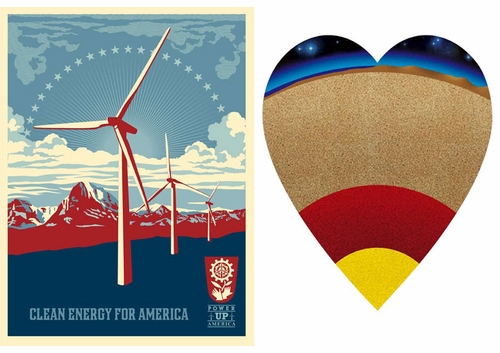 The first two waves had great success. First wave: the creation of our National Forests, the passage of the Wilderness Act of 1964; second wave: the passage of the Clean Air Act, the creation of the Environmental Protection Agency. Our air and water are cleaner and more land is protected. Our very consciousness about the environment has changed. We have become more sensitive to ecology. Yet Krupp was right to point out that the environmental movement needed a new direction, a third wave, and that the old paradigms starkly opposing industry and nature were worn out and counterproductive. An emphasis on conservation and purity made the movement seem precious and out of touch. Not far off were the cries concerning “the end of nature” and “the death of environmentalism” (both titles of books that would be published in the years to come). The problem is that twenty years later the focus has been found, but the strategy has not. Climate change is clearly the challenge of our times, but is the environmental movement doing a good job of motivating the public to address it? In our view, despite its successful history and the urgency of its current agenda, the environmental movement has not evolved to meet the challenge of this third wave. It is broad but weak—weaker than it should be given the imperative of its message. It is a movement that primarily seems to concern affluent people in mostly superficial ways. Younger people, who are the real stakeholders given that they will inherit an environment on the verge of collapse, are weirdly apathetic, hedonistic, and cynical. Less affluent people, who are the most likely to feel the impacts of climate change—crashing economies and starvation—can’t find enough head-space for these concerns in a world overcrowded with anxieties. Conservatives have become convinced that this once nonpartisan issue is now a threat to their core values. America’s future is at stake and precious few seem to really care or even understand. 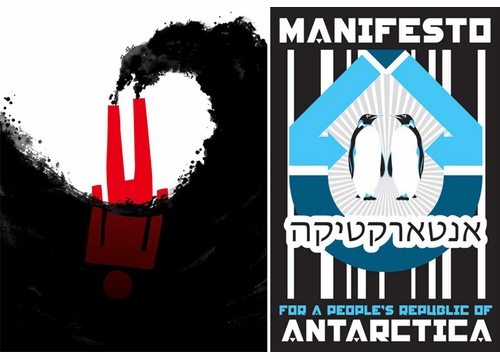 Why Graphic Design? So why graphic design? What can it do? The inspiration came first from WPA (Works Progress Administration) and World War II posters. During the war the United States was able to mobilize industry and its citizens with breathtaking speed. Factories were overhauled and consumption habits were transformed. Conservation (in the form of rationing) became a patriotic act. Strong, graphically compelling posters played a crucial role in the success of this campaign. In these posters, taking action was presented as vital for the good of the nation, and those who were willing to sacrifice were portrayed as dynamic American heroes. This is just what we need today. Contrast the power and effectiveness of these World War II images with some of the current visual media in the environmental advocacy realm. In the latter there are essentially three modes: 1) Save the Earth (which to us seems meaningless and apparently strikes the general public as crying wolf); 2) Save the animals (not meaningless at all, but dodges the crux of the matter: future human suffering vs. continued human prosperity); 3) Eco-apocalypse (a legitimate possibility, but a trope that often feels whiny and too distant to be actionable). All of these strategies also suffer from the fact that by the time their truth is tangible to the public it will be far, far too late. So what is right for our time? We took the approach that no one person knows the answer, and that is why we opened up the project to multiple designers and to the general public. But the posters we selected for this book represent a particular vision—the vision of the editors. We believe that graphic design does not just respond to the zeitgeist— it helps shape it. With that in mind we generally sought posters that convey urgency and/or optimism (in a word: strength), but we remained open about the specific content or imagery we received. 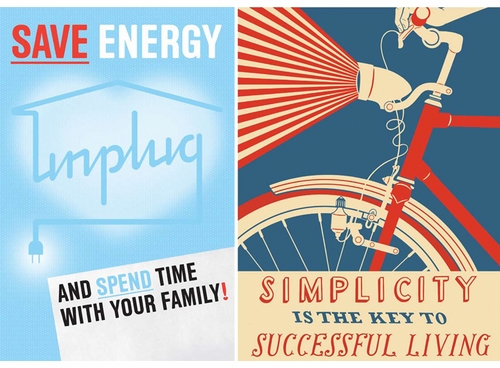 Working with Irony, Cynicism, and Attention Deficit Conceptual problems and lingering clichés were not the only obstacles we faced as we began to wade into the design community. Society has changed since the environmental movements of the ‘60s and ‘70s and, of course, it has changed even more since World War II. Our culture has become extremely skeptical of, even hostile to, sincerity, conviction, and inspiration. Visual culture is dominated by irony, detachment, and snark. Idealism in visual communication is perceived as phony and quickly parsed for inconsistency and hypocrisy. Designers and marketers have created a visual culture that is almost toxic for advocacy. Brazen dishonesty in advertising and branding have made the public rightly suspicious, but perhaps more pernicious is the fact that once that dishonesty became widely understood, it was replaced with a kind of self-referential nothingness. Ads are filled with nonsequiturs, boring office set-ups, and talking babies. Graphic design has become glib and self-deprecating in the extreme. Dishonesty has been replaced with a void. Part of the reason for this void is the lack of institutions with the cultural or social authority to back up a call to action. The World War II posters we were inspired by were effective partly because there was confidence in our government and the industries that supported the war effort. People were likely not only to trust the government, but also to feel a sense of common purpose with it. Today virtually all institutions—government, the military, the press, big business—are viewed with suspicion, if not hostility. Environmental activists deserve some of the blame for this. Legitimate criticism and protest have evolved into a culture of knee-jerk antibusiness, antigovernment conspiracy theories to the point where all big institutions (even large environmental organizations) are considered illegitimate because of their size. Unfortunately we will need big institutions and mass organization to get us out of this mess. Such deep-seated cynicism created one of the core challenges that faced this project. It was clear that no institutional partner or media sponsor would likely inspire meaningful participation. In our networked culture it is the individual that has credibility, not institutions. People trust their friends; they don’t trust the government. Consensus comes in the form of a mesh of likes, links, comments, and recommendations. The institutional has been replaced with the social. To be credible we had to make our own mini– social network that enabled the authority and credibility of the community to guide the project. The Green Patriot Posters website enables peer-to-peer creation and valuation of images through online submissions, community-based voting, and frictionless sharing across social networks. 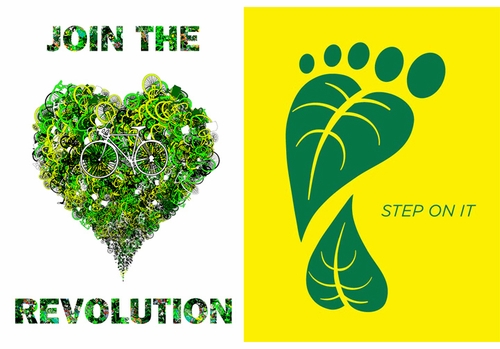 Miniature Monuments Basing a poster project around a website seemed like a bit of a contradiction. The obvious question (one that came at us often) was, “Why posters”? The web has not only changed how consensus and community work; it has become the dominant medium for visual communication as well. Posters were traditionally a way of dominating public spaces like street corners and bus stations, but now our public space is online. How does a poster work in a world where it is more likely to be seen on a Facebook wall than an actual wall? One fundamental principle of this project is that the poster has retained the power and impact of its roots even as it has been squashed down into a jpg. The idea of the poster has survived even as the context and medium have shifted. This is partly because, ironically, the design challenge of making something impactful in a Twitter feed is very similar to that of making something readable from across the street. It requires scale, contrast, and bold messaging. In the endless stream of information and updates that characterizes the web, the visual properties of a poster are quite effective—they are miniature monuments. Each online poster also serves as a thumbnail for a bigger idea, a hyperlink to the greater project of fighting climate change. Building a better button is now more important than building a better mousetrap. A clever or arresting poster design garners clicks; the quality of its design is a call to action in and of itself—“click here.” The Obama Campaign and Fairey’s Hope Poster The relative weakness of the environmental movement, the lack of credible public institutions, and the fracturing of our culture into a peer-to-peer network made us doubtful that public art or cause-related imagery could have a meaningful impact in fighting climate change. But Barack Obama’s campaign for president changed that. For the first time in a generation, there was a cause, a movement, an institution that young people felt was worthy of not just trust, but also action and personal sacrifice. And a poster played a major role in that campaign. Shepard Fairey’s poster Hope demonstrated that an unironic, idealistic image could take hold in our culture and inspire people, particularly young people, the way World War II posters had. It was the widespread embrace of that image and the vision of young people volunteering on the campaign and voting in record numbers that made us feel like a poster might actually be able to contribute to a broader movement for sustainability and the fight against climate change. Our hope has been affirmed by the quality and the sheer number of poster designs that continue to flow into the Green Patriot Posters website. Clearly there is a great deal of interest in rallying around the fight against climate change to create a more sustainable future. 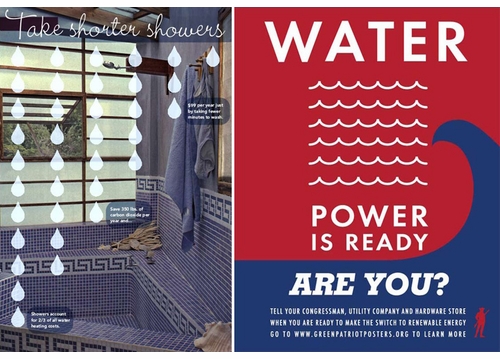 What We Got As posters started rolling in some inspired us, some depressed us, and some just confused us. But several topics recurred, including bicycles, local food, and renewable energy/the end of oil. Notably each of these is positive, solution-oriented, visualizable, and realizable, and each gives distinct agency to the individual. The bicycle is a nonthreatening, nonideological image, unsanctimonious and almost childlike. At the same time its mere presence is a direct challenge to our car culture, which drives so much CO2 into our atmosphere. It is also a symbol of individual responsibility and empowerment in the face of an overwhelming challenge. As we mentioned above, the individual is the most meaningful institution in our culture today, so it is probably no coincidence that the bicycle—a vehicle built for one—would be so resonant. Posters about local food were among the most fun and the most inclined to employ retro imagery—a reminder that the values of this movement have deep roots in American society. Alternative technologies were valorized in many of the posters, including Fairey’s iconic windmill. These images reflect a faith that technology and innovation are the great assets of America that will surmount the challenge of climate change—an interesting update to the qualities of determination, grit, and resourcefulness, which were the focus of the World War II–era posters. These works represent a yearning for a different kind of industry, one that harnesses technology, capital, and innovation in the interest of more than just shareholder value—actual values. There is clearly an opportunity for energy companies to replace reckless, shameless practices like deep-water drilling with clean-energy exploration. Not surprisingly, many designers, particularly many of the youngest designers, deftly adapted the humor and irony that dominate our culture to the cause, hijacking this vernacular for a higher purpose. Jeremy Dean’s co-opted rap lyric in It’s Getting Hot in Here and Xander Pollock’s melting of Al Gore’s face proved that a contemporary environmental movement needs to speak in a contemporary language. Several designers, perhaps frustrated with the lack of credible institutions, made up fictitious ones—Eric Benson’s Renewable Electrification Administration, DJ Spooky’s People’s Republic of Antarctica. Yet what struck us the most was the polyphonic nature of the submissions. There is no one prevailing ethos, aesthetic, or message. We see this as a strength, not a weakness. It is a sign of the times and of what is needed to invigorate the environmental movement to address the challenges of climate change and energy independence: flexibility, dynamism, and the embrace of complexity and multiplicity.  Making the Book As the posters piled up, the pressure mounted to compile the best of the best into a book. We were skeptical. We have a lot of books. They generally sit on the shelf or in a pile. For a project that was dedicated to action and reducing consumption, how could we justify producing something that would consume a lot of energy and resources largely to fill shelf space? We decided that if we were going to make a book, it had to have a purpose consistent with the project overall, and it had to be printed sustainably. Working with Monroe Litho in Rochester, New York, we set the page count and trim size to minimize waste in the printing process. The book was printed domestically, using 100 percent wind-generated electricity (through the purchase of Green-e certified renewable energy certificates); vegetable-based inks; and paper that is made in New York with 100 percent post-consumer recycled material, 100 percent wind-generated electricity, and is FSC (Forestry Stewardship Council) certified. (The cover paper is made with 80 percent post-consumer recycled material.) Yet financial realities being what they are, the publisher could not afford to print a book this way and stay in business. So we had to search for funders. In other words we created an artificial economy through donor intervention. Those donors, who deserve as much credit for this book as anyone, are: Environmental Defense Fund, Richard H. Goodwin, Judith Bell, Neva Goodwin, Gabe Nugent, Hiscock & Barclay, and an anonymous source. It bears emphasizing that a subsidy from donors is not a good long-term solution to any business problem. Ultimately more publishers, more businesses, have to be committed to doing things the right way (making fewer books at a higher price, or whatever it takes) to move the economy in the right direction. It would not be so expensive to print sustainably if there was higher demand for it. In making the book we felt that in order for it to be meaningful, it had to be active. For this reason we wanted the posters to be detachable and spreadable. In this way the book becomes a means of distribution and personalization, and a source of energy. We want you to destroy this book. We hope you will tear out the pages and display them, in your room, your office, your locker—wherever. We did not want to make a monument or a historical record; the website will serve as a more effective and public monument to the project. We wanted to distribute the posters and give people an affordable way to own and display them. 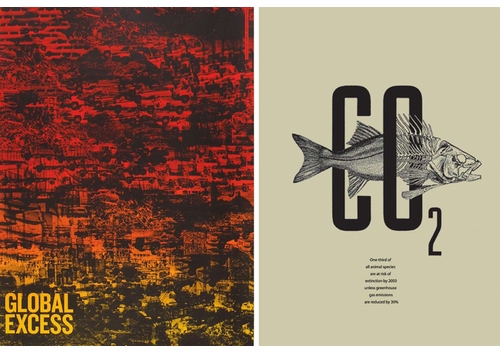 What Do I Do Now? Obviously the poster itself does not create the change we need. That takes people. So what do we hope is the outcome of our book? Real movement-building. And that takes time. If you are inspired by a poster, tear it out and hang it up. Or carry it at a protest. Or find it on our website and pass it on digitally. Make your own poster. Post it. Let it enter the culture and begin its work changing consciousness. If you want to do more, do it. On the back of each poster is a link to “Go Further” with an idea or action represented in the design. Creating a strong, visible sentiment that raises eyebrows and pushes markets and policy is work in and of itself. But this book is not just about graphic design; it’s about making real change. Follow a few of the links in the book. Act—and urge others to do the same. Hold yourself and others accountable. The most important people to hold accountable are your elected officials. Contact your representatives; organize a demonstration or other local action. Be louder, more insistent, and more persistent. Create the third wave. The ball is in your court.  Green Patriot PostersMetropolis Books |
